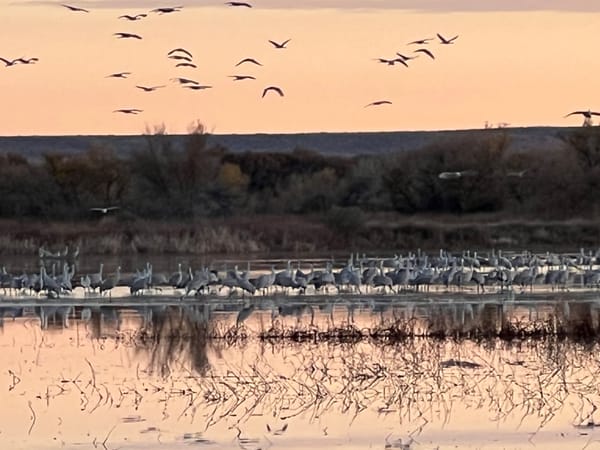Lock the Gates?
The case for closing national parks during a government shutdown
It's budget season in Washington, D.C., and we all know what that means: the threat of another government shutdown once again looms. The federal government's fiscal year ends on midnight, September 30. Avoiding a shutdown will require a divided Congress to either pass all 12 appropriations bills for 2026 before the deadline (aka, "an act of God"), or pass a continuing resolution to extend funding at least until January 1 (aka "punting").
Every time Washington stumbles into a budget crisis, another question looms: should America’s national parks remain open during a government shutdown? The instinct to keep them accessible is understandable. These landscapes belong to the people, small towns outside the park depend on the visitor business they attract, and, for many families, a visit to a national park is a once-in-a-lifetime pilgrimage. Closing them feels like punishing Americans for endless D.C. dysfunction.
But our recent history has taught us a hard truth: leaving parks open without staff is a recipe for destruction, danger, and disrespect. The most responsible policy during a shutdown is also a uniquely unpopular one: close the gates.
Consider what happened during the 35-day shutdown in the winter of 2018–2019, the longest in U.S. history. Despite most park staff being furloughed, parks remained partially open. There were few or no rangers to enforce rules, bathrooms and campgrounds were closed, and visitors were left to improvise.
A trip to Glacier NP during the 2018-2109 shutdown
Trails in Yosemite overflowed with human waste after bathrooms filled up and trash went uncollected. In Joshua Tree National Park, vandals cut down iconic, hundred-year-old trees; off-road vehicles tore through sensitive desert landscapes; and campers squatted in illegal areas.
“What’s happened to our park in the last 34 days is irreparable for the next 200 to 300 years,” former Joshua Tree superintendent Curt Sauer told the crowd at a rally after the shutdown.
The National Park Service was trying to make the best of a dysfunctional situation. By keeping parks technically “open” but unstaffed, it sent the message that visitors were welcome, even as basic protections had collapsed.
Contrast that with the 2013 shutdown, when the Obama administration made the unpopular decision to completely close national parks. That decision understandably created a backlash. Veterans knocked down barricades at the World War II Memorial in Washington, D.C. Families who'd planned visits months in advance were turned away at Yellowstone and the Grand Canyon. And gateway communities faced an existential loss of business.
The economic fallout in Tusayan, Arizona, just outside the Grand Canyon, was estimated at more than $1 million per day. In Estes Park, Colorado, just outside the entrance to Rocky Mountain National Park, business owners reported losing tens of millions in a matter of weeks.
These were crippling impacts, but at least there was clarity. While 2013 was painful for people, 2018–2019 was painful for the parks themselves. If the mission of the National Park Service is to preserve these places “unimpaired for future generations,” the choice between the two approaches is obvious.
Some experts advocate for a compromise: keep the scenic overlooks and through-roads open, but close visitor centers, campgrounds, and backcountry access. This sounds sensible on paper, but in reality, it could create more confusion and chaos.
During the 2018–2019 shutdown, some states like Utah and Arizona scrambled to use their own funds to keep certain parks operating. Governors saw it as both an economic lifeline and a political win. But not every state had the resources or political will to do the same, and the result was an uneven patchwork. A family visiting Bryce Canyon might have found open restrooms, while those visiting Big Bend found locked gates and no rangers in sight.
Partial openings also invite a dangerous illusion of normalcy. Visitors arrive expecting the full park experience, only to discover no one is there to help if they’re lost, injured, or in danger.
What's more, we're already seeing damage from the National Park Service staffing cuts. In Joshua Tree this spring, shortly after many rangers and other park employees received termination notices, vandalism increased. Why should we expect anything different when zero staffers are in the park?
Protecting local economies is the strongest argument against closures. Towns outside park boundaries often depend almost entirely on tourism. According to the National Park Service, visitor spending in 2022 supported over 378,000 jobs and contributed $50 billion to the U.S. economy. When parks close, those numbers plummet overnight.
That pain is real, and it shouldn’t be dismissed. But here’s the uncomfortable truth: leaving parks open without staff doesn’t save local economies either. In 2018–2019, news of overflowing toilets and trashed campgrounds deterred many would-be visitors. People don’t want to come if the park is in disarray. Gateway towns rely not just on visitor numbers, but on the promise of a safe, inspiring experience.
If Congress wants to protect these communities during a shutdown—which it should—maybe a better solution is to provide direct relief such as emergency grants, bridge loans, or tax credits to businesses that lose revenue through no fault of their own.
Closing the parks during a shutdown is not about punishing the public. It’s about refusing to treat these places as pawns in a political standoff. A closed gate may disappoint a family for a week. An open gate during a shutdown can scar a landscape for generations.




